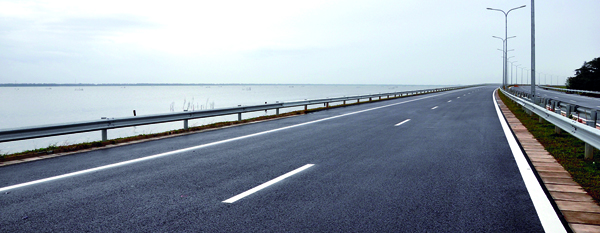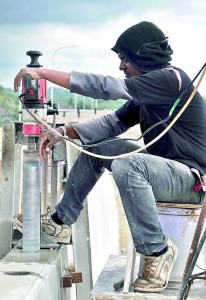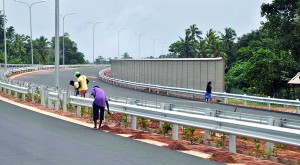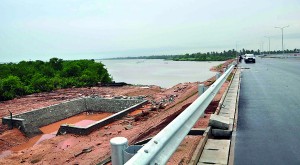Sri Lanka’s newest beauty: E03-the Katunayake expressway
ON THE NEW HIGHWAY – Entering Colombo after just landing at the Bandaranaike International Airport (BIA) is set to get you in about 20 minutes to the city on the new (Katunayake) expressway E03 scheduled for opening in September this year on a ride totaling 25.6km.

Pix by Indika Handuwala
The expressway is composed of 100 box culverts and about 40 bridges along with four inter changers at New Kelani Bridge, Peliyagoda, Ja-Ela and Katunayaka, Colombo – Katunayaka Expressway Project Director P. Gunaratne said in an interview with the Business Times on Wednesday. In future it is expected to have another inter change at Kerawalapitiya once the Outer Circular Road completes construction.
A challenging feature of construction engineering in Sri Lanka was doing something not tried before in local projects in the construction of a 170 metre long beam supported by columns of 35 metres spacing for the Katunayaka bridge constructed using Chinese technology, he explained.

Pix by Indika Handuwala
Another aspect is the top – down construction of the bridge on the Negombo-Mabola road under which would run the expressway that was completed within three months in order to ensure that traffic was not disrupted, he said. The steel columns below were drilled into the earth after which the earth was removed after constructing the road above.
In addition, construction work of the expressway along the Muturajawela marshes proved challenging as there was a short supply of filling material and since deep land filling was needed due to the loose soil it was also very costly. About 125 km of filling material was in short supply and instead engineers used sea sand that took about six to nine months to settle.
Driving into the city would be a smooth ride not to be missed as travelling on the 100 km per hour toll road into Colombo would allow visitors to be treated to the waterways and greenery en route.
Welcome arrival
The Colombo-Katunayaka Expressway merges with the existing road leading to the airport and crosses over the railway line with a bridge considered to have been constructed without causing any obstruction to the existing roads or rail.
The road then goes further down from the edge of the Negombo lagoon giving a wonderful view of the waterway on the right and other canals constructed on the left to provide access to easy water flows that were previously blocked.
Along the way over-passes and under-passes allow both pedestrians and vehicle traffic to travel smoothly across the expressway without causing disturbances to any of the existing roads.
Driving along the expressway from Katunayaka the next interchange at Ja-Ela allows those wanting to move out can do so as it connects with the Ja-Ela town and the Tudella – Pamunugama road.
Mr. Gunaratne explained that those wanting to enter the expressway from Gampaha were able to do so by travelling to Ja-Ela town and then along the one kilometre route to the toll road.
The expressway runs below the Negombo road at Mabola and in the future once the Outer Circular highway would be constructed it would link up at the Kerawalapitiya interchange which is currently under construction.
In the Hunupitiya area the expressway runs along a 400 metre bridge passing the Ceylon Fertilizer Company to the railway line.
Driving into the city would cut across the Muthurajawela marshes for an extent of about 17 km along which one could at present see the illegal slum dwellings that would be screened in the future with a high rise fence on which creepers would be trained as a cover.
Visitors could then enter the city at the Peliyagoda inter change that connects with Thorana junction on the Colombo – Kandy road and Wattala on the Negombo road; or proceed down further to the New Kelani bridge where the road commences from the Colombo end and merges with the existing city road.
History behind the expressway’s long drive
Sri Lankans have always been interested in linking up with the international airport from the main city as far back as the 1960s.
The project director explained that during that time though there was no intention of constructing an expressway the need was more for a highway. This project then kicked off with construction work commencing at the Kelani bridge with land filling but was later abandoned.
He noted that later in 1991 the Japanese government funded project was proposed for the same project for which a feasibility study was carried out and a road trace selected on the Eastern side of the existing Colombo-Katunayaka road known as the Eastern trace.
However, repeated public protests against the construction of the expressway during this time caused disruption to the work as the government was compelled to abandon the project since dwelling locations would be disturbed.
In the 1990s the project was once again mooted for which a feasibility study was carried out by the Road Development Authority (RDA) onto the West of the Colombo-Katunayaka road known as the Western trace. At the time, the government was looking at implementing the project through local funding and the contract was awarded in 2000 to Daewoo Keangnam, a Korean construction company for approximately an estimated cost of Rs.12 billion.
Though work commenced on the said project it was mutually terminated three years later due to the lack of local funds and the difficulty in making payments for the project, Mr. Gunaratne observed.
He noted that however, in 2006 the Chinese government offered funding from the Exim Bank with a contractor picked from the same country and in this respect, China Metallurgical Group Corporation, a Fortune 500 company.
Agreement was signed in 2008 and the loan process took more than one year and actual construction started in August 2009 for a contract period of 36 months for the 25.6km road at an estimated cost of US$292 million. The cost of the project increased, the project director explained due to the increased scope of work and new methods adopted in addition to increased safety requirements, which was included in the total estimated cost of the project.
The government would finance 15 per cent of the project through local funding as part of the conditions laid out by the China government it was noted.
Key Features
Some of the features of this expressway would be the lanes that have been widened to six from four to accommodate the large number of structures across the Muthurajawela marshes with bridges and box culverts.
A toll free extent is available allowing traffic to divert from the New Kelani Bridge upto Peliyagoda inter change from which point onwards they would be charged for their drive into Katunayaka.
A three track lane would be available from New Kelani Bridge to Peliyagoda after which there would be only a two track lane of 3.75 metres each on either side with an emergency lane of 3 metres also provided right along in case of an accident to ensure traffic could be diverted without obstruction.
In addition, emergency exits have also been established along the expressway that could be opened up in case of an accident along the route to ensure that those injured could be rushed to the nearest hospitals by opening up the barriers on the centre for which personnel would be deployed in this regard.
A median of three metres is provided between the lanes for “Christina” plant pushes to ensure that oncoming vehicles would not be obstructed with any glare from the other side and to ensure an eco friendly nature right along the route. Within this median path is a drain established to ensure that the water could move out through these drain without spilling over to the other lane.
Along the Muturajawela marshes the Old Negombo Canal that runs parallel to the expressway has been widened under this project which was initially constructed during the Dutch period. In the future, the government would be looking at beautifying this canal as well by allowing visitors to take a drive along the water ways on boat rides.
A unique aspect of this project is the street lighting that would be provided right along the entire extent of the expressway to ensure that drivers do not find difficulty in travelling along the route.
In addition, it was explained that a geo-grid retaining wall was constructed using solely rocks without the use of cement to ensure firm retentions without cutting too deep into the soil.
Unlike the existing Southern Expressway, the E03 would be provided with required safety features to ensure that vehicular traffic was given a smooth flow at certain exit and entry points with the use of traffic signals.
In addition, within a spacing of approximately 20 metres an asphalt bed has been laid out on the sides of the road constructed out of sand and tar alone to ensure that the water is drained out only at these particular locations along the expressway into the drains constructed below.
Eco –friendly construction
Moreover, sound barriers costing US$367 (Rs.45, 875) per linear metre for foundation, material and installation was established at intervals to ensure no noise pollution from traffic would affect the surrounding housing at a distance of 20-25 kms. These sound barriers would be established along at intervals for 3.56 kms and another aspect of the expressway is the 800 metre long green belt in Seeduwa. Separation tanks have been established to ensure that any plastics or oil would not be allowed to enter the Negombo lagoon at certain points thereby conserving the environment and allowing for the fish breeding points close to these locations to be pollution-free.
Rock filling carried out at the Negombo lagoon for a length of 1.2 km has been compensated with an enlargement of the lagoon as recommended by the Central Environment Authority (CEA) and the Sri Lanka Land Reclamation Board.
Beautifying the expressway meant the RDA had to work on streams that did not exist before that would then overflow into the Mudun Ela, Kalu Oya and the Old Negombo canal.
Construction work was completed by a labour force of about 1000 locals and indirect workforce of 50, 000 and about 500 Chinese labour out of which at least 300 were still engaged with housing provided for them along the route.
Mr. Gunaratne explained that upto now they had not recorded any single fatal accident on the project and would be ready by September with landscaping underway at the inter changers.
In addition, animals would be warded off through a mesh on either side of the road since a number of stray dogs and even ducks with their families were seeing crossing the expressway during the Business Times drive.
Maintenance work of the expressway would be carried out through a separate division established within the RDA in this regard, it was pointed out adding that the toll would also be utilised for this purpose as well.
| Relocating lost dwellers
Project Director P. Gunaratne observed that due to the construction work affecting livelihoods of both legal and illegal housing they had spent at least Rs.2600 million worth of compensation for those in Ja-Ela , Katunayaka and the Kenai Bridge area.Relocation was carried out for about 400 houses for those on privately held property and even 300 unauthorised houses built on state lands. |
Follow @timesonlinelk
comments powered by Disqus


